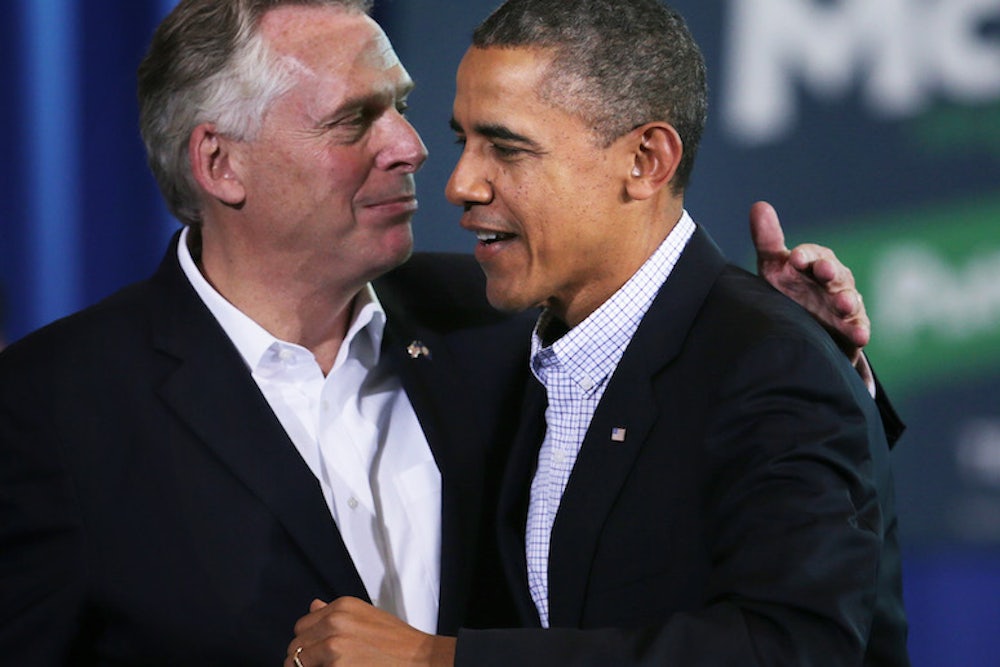With Terry McAuliffe’s gubernatorial victory over Ken Cuccinelli, Democrats have now won seven of Virginia’s eight high-profile, statewide races since 2005 (three Senate races, two Presidential contests, and two of three gubernatorial elections). The lone exception, Bob McDonnell’s gubernatorial victory in 2009, provides an instructive contrast with the current contest.
In 2009, Virginia voters were 78 percent white and 22 percent minority. In 2013, they were just 72 percent white and 28 percent minority—not far off the 70/30 split in the 2012 presidential election. There you have the key to McAuliffe’s victory: Despite performing much better among white voters than the hapless Creigh Deeds, McDonnell’s Democratic opponent, McAuliffe would nevertheless have lost this election if the white/minority voter distribution had mirrored that of 2009. It was the increase in the minority vote that put him over the top.
This has important implications for Virginia’s status as a purple state. In any statewide election where the distribution of actual voters gets fairly close to the distribution of potential voters, the Democrats have a built-in advantage. Ongoing demographic change has transformed the underlying electorate into one that leans blue rather than red. The problem for the Democrats is getting that underlying electorate to show up. In the 2013 election, they succeeded—or succeeded enough to win a 3-point victory.
This 3-point victory was not far off Obama’s 4-point victory in 2012. Other data from the election underscore the similarities between the Obama coalition and the McAuliffe coalition. Not only was the minority share of voters in 2013 close to the minority share in 2012, so were Democratic support levels among these voters. Black voters gave McAuliffe 90 percent of their ballots, compared to 93 percent for Obama in 2012. And, while the exit poll did not report Hispanic and Asian figures due to small sample size, Latino Decisions’ election eve poll of Hispanics and Asians indicates their support levels for McAuliffe were very similar to Obama’s in 2012: 66 percent and 63 percent, respectively, compared to 64 percent and 66 percent in 2012.
McAuliffe’s support from unmarried voters was also very close to Obama’s. Among unmarried men and women, he received, respectively, 58 percent and 67 percent of the vote, compared to 57 percent and 64 percent for Obama in 2012.
Geographical patterns also suggest how new, potentially durable voting patterns benefit Democratic candidates, even fairly weak ones like McAuliffe and even in non-presidential years. In Fairfax county, Obama prevailed by 21 points, McAuliffe by 22 points; in Loudoun county, it was Obama by 5 points and McAuliffe also by 5 points; and in Henrico county around Richmond, it was Obama by 12 points and McAuliffe by 13 points.
The same story is told by the exit polls’ regional breakouts of the data. In the DC suburbs, Obama won by 27 points, McAuliffe by 29 points; in the Richmond area, Obama prevailed by 3 points, McAuliffe by 4 points; and in the Tidewater area, it was Obama by 14 points and McAuliffe by exactly the same margin.
All this despite the unapologetically liberal campaign run by McAuliffe. Instead of running to the right of the national party, as has been traditional with Virginia Democrats, McAuliffe endorsed gay marriage; supported universal background checks for gun purchases and an assault-weapons ban; supported a pathway to citizenship for illegal immigrants; backed Obamacare, including the expansion of Medicaid in the state; insisted on an employer mandate to include free contraception coverage in health insurance coverage; supported limits on carbon emissions from new coal-fired power plants; and called for ending tough restrictions on abortion clinics.
Of course, some argue that Cuccinelli was a weak candidate, so McAuliffe should have prevailed by a larger margin. But McAuliffe was a weak candidate as well and the fact remains that this “blue state” agenda, if you will, did not scare Virginia voters away but rather carried him to victory. That’s because today’s Virginia voters are fundamentally different from those of the past.
There will continue to be endless dissections of the Virginia results, as analysts argue over why McAuliffe’s margin was “only” 3 points and point fingers at suspects like the botched roll-out of Healthcare.gov. But a few years down the road, this election is likely to be remembered not for any of these arcane debates, but rather for marking another step along Virginia’s transition from red to purple to blue.
Correction: This article originally state that Democrats had won six of seven recent statewide contests when the correct number is seven of eight recent statewide contests.
